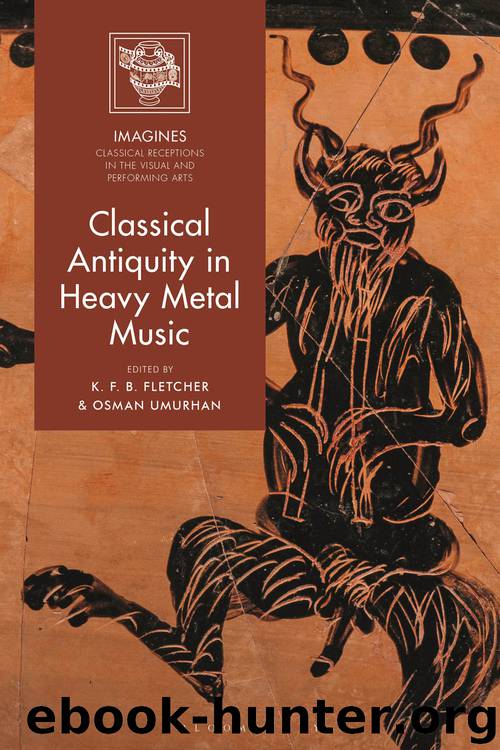Classical Antiquity in Heavy Metal Music by K. F. B. Fletcher;Osman Umurhan;

Author:K. F. B. Fletcher;Osman Umurhan;
Language: eng
Format: epub
ISBN: 9781350075375
Publisher: Bloomsbury UK
Published: 2019-07-21T16:00:00+00:00
The transmission and reception of Caligula
Gaius Julius Caesar Augustus Germanicus, better known as Caligula (12–41 CE), was the third emperor of the Roman Empire (37–41 CE).8 He is also arguably the most infamous of the emperors, depicted since antiquity as cruel, incestuous, delusional, and egomaniacal. Although recent scholarly works have argued that this portrait of him is overblown or even completely fictional, it is so pervasive and well-established that it still dominates outside of academia, and influences Ex Deo.9 As so much work has been done on the reception of Caligula, only a brief overview is needed here to sketch out his main characteristics in the tradition. I will return to individual negative details as they appear in Ex Deo’s songs and videos.
The three most influential early authors for subsequent views of Caligula are Philo, Seneca, and Suetonius. Philo (ca. 20 BCE–50 CE), an Alexandrian Jew who personally met Caligula when he led a Judean embassy to Rome, describes the emperor as a wild, delirious person possessed by a great frenzy and insanity (Legat. 93). Seneca the Younger (ca. 4–65 CE), a senator and philosopher, was another contemporary of Caligula. He alludes to the emperor in many of his treatises, and describes him as an unstable and furious ruler greedy for human blood (Ben. 4.31.2). Although Suetonius (ca. 70–ca. 138 CE) was not a contemporary, his biography has exerted the most influence on the modern reception of Caligula. Because he worked as a manager of public libraries and the imperial archives during the reign of Hadrian, his account was long supposed to be based on reliable sources. While recent work has criticized the likely senatorial bias of such sources, Suetonius’ biography of the emperor is the most scandalous of the twelve in his De vita caesarum (On the Life of the Caesars), and is the source of most of the (in)famous details about Caligula’s life and character.
After a dramatic childhood and youth in which his siblings either died or were executed, Caligula became the successor to Tiberius (14–37 CE). The ancient authors record that after a hopeful beginning and an enigmatic illness, his reign deteriorated into a string of countless scandals, arbitrary abuses of the senatorial class, and megalomaniac whims that would eventually lead to his assassination.10 As Suetonius so memorably puts it (Calig. 22): Hactenus quasi de principe, reliqua ut de monstro narranda sunt (“So much for Caligula as emperor; we must now tell of his career as a monster”).11
Seneca’s and Suetonius’ presentation of Caligula are complementary. The emperor appears in eight of Seneca’s twelve Dialogi as an example of vice, and the antithesis of every Stoic virtue: excess of emotion, waste of money, verbal abuse, cruelty, anger, cowardice, and hubris.12 Suetonius may have been influenced by the depiction of Caligula in Seneca (Lindsay 1993: 9), and the part of his biography that depicts the emperor as a monster (Calig. 22–60) presents the quintessential bad ruler, focusing on the sensational and the shocking (Southon 2017: 188). Suetonius goes so far as to describe Caligula using the Latin word monstrum (Calig.
Download
This site does not store any files on its server. We only index and link to content provided by other sites. Please contact the content providers to delete copyright contents if any and email us, we'll remove relevant links or contents immediately.
4 3 2 1: A Novel by Paul Auster(11794)
The handmaid's tale by Margaret Atwood(7455)
Giovanni's Room by James Baldwin(6814)
Big Magic: Creative Living Beyond Fear by Elizabeth Gilbert(5359)
Asking the Right Questions: A Guide to Critical Thinking by M. Neil Browne & Stuart M. Keeley(5358)
Ego Is the Enemy by Ryan Holiday(4960)
On Writing A Memoir of the Craft by Stephen King(4667)
The Body: A Guide for Occupants by Bill Bryson(4587)
Ken Follett - World without end by Ken Follett(4448)
Bluets by Maggie Nelson(4263)
Adulting by Kelly Williams Brown(4236)
Eat That Frog! by Brian Tracy(4153)
Guilty Pleasures by Laurell K Hamilton(4120)
White Noise - A Novel by Don DeLillo(3832)
The Poetry of Pablo Neruda by Pablo Neruda(3820)
Fingerprints of the Gods by Graham Hancock(3740)
Alive: The Story of the Andes Survivors by Piers Paul Read(3732)
The Book of Joy by Dalai Lama(3700)
The Bookshop by Penelope Fitzgerald(3621)
